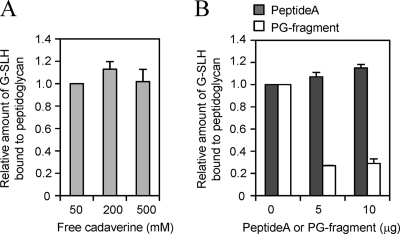FIG. 4.
The structural constituent of the peptidoglycan required for interaction with SLH domain. The assay for G-SLH binding to peptidoglycan was performed in the presence of free cadaverine (A) or peptide A or the PG fragment (B). The free cadaverine, peptide A, or PG fragment was exogenously added to the reaction mixture containing G-SLH and 1 mg of peptidoglycan from wild-type S. ruminantium, and the relative amount of G-SLH bound to the peptidoglycan was measured.

